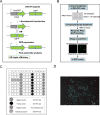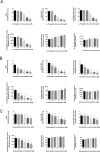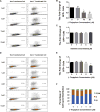Natural product β-thujaplicin inhibits homologous recombination repair and sensitizes cancer cells to radiation therapy
- PMID: 29112893
- PMCID: PMC5909195
- DOI: 10.1016/j.dnarep.2017.10.009
Natural product β-thujaplicin inhibits homologous recombination repair and sensitizes cancer cells to radiation therapy
Abstract
Investigation of natural products is an attractive strategy to identify novel compounds for cancer prevention and treatment. Numerous studies have shown the efficacy and safety of natural products, and they have been widely used as alternative treatments for a wide range of illnesses, including cancers. However, it remains unknown whether natural products affect homologous recombination (HR)-mediated DNA repair and whether these compounds can be used as sensitizers with minimal toxicity to improve patients' responses to radiation therapy, a mainstay of treatment for many human cancers. In this study, in order to systematically identify natural products with an inhibitory effect on HR repair, we developed a high-throughput image-based HR repair screening assay and screened a chemical library containing natural products. Among the most interesting of the candidate compounds identified from the screen was β-thujaplicin, a bioactive compound isolated from the heart wood of plants in the Cupressaceae family, can significantly inhibit HR repair. We further demonstrated that β-thujaplicin inhibits HR repair by reducing the recruitment of a key HR repair protein, Rad51, to DNA double-strand breaks. More importantly, our results showed that β-thujaplicin can radiosensitize cancer cells. Additionally, β-thujaplicin sensitizes cancer cells to PARP inhibitor in different cancer cell lines. Collectively, our findings for the first time identify natural compound β-thujaplicin, which has a good biosafety profile, as a novel HR repair inhibitor with great potential to be translated into clinical applications as a sensitizer to DNA-damage-inducing treatment such as radiation and PARP inhibitor. In addition, our study provides proof of the principle that our robust high-throughput functional HR repair assay can be used for a large-scale screening system to identify novel natural products that regulate DNA repair and cellular responses to DNA damage-inducing treatments such as radiation therapy.
Keywords: DNA repair; Homologous recombination; PARP inhibitor; Radiosensitizer; β-thujaplicin.
Copyright © 2017 Elsevier B.V. All rights reserved.
Conflict of interest statement
The authors declare that there are no conflicts of interest.
Figures







Similar articles
-
A novel UCHL3 inhibitor, perifosine, enhances PARP inhibitor cytotoxicity through inhibition of homologous recombination-mediated DNA double strand break repair.Cell Death Dis. 2019 May 21;10(6):398. doi: 10.1038/s41419-019-1628-8. Cell Death Dis. 2019. PMID: 31113933 Free PMC article.
-
LRRK2 inhibition potentiates PARP inhibitor cytotoxicity through inhibiting homologous recombination-mediated DNA double strand break repair.Clin Transl Med. 2021 Mar;11(3):e341. doi: 10.1002/ctm2.341. Clin Transl Med. 2021. PMID: 33784003 Free PMC article.
-
Ferulic acid in combination with PARP inhibitor sensitizes breast cancer cells as chemotherapeutic strategy.Biochem Biophys Res Commun. 2015 Mar 13;458(3):520-524. doi: 10.1016/j.bbrc.2015.01.147. Epub 2015 Feb 10. Biochem Biophys Res Commun. 2015. PMID: 25677620
-
Homologous Recombination-Mediated DNA Repair and Implications for Clinical Treatment of Repair Defective Cancers.Methods Mol Biol. 2019;1999:3-29. doi: 10.1007/978-1-4939-9500-4_1. Methods Mol Biol. 2019. PMID: 31127567 Review.
-
PARP inhibitors for anticancer therapy.Biochem Soc Trans. 2014 Feb;42(1):82-8. doi: 10.1042/BST20130187. Biochem Soc Trans. 2014. PMID: 24450632 Review.
Cited by
-
Design, synthesis and biological evaluation of 2-quinolyl-1,3-tropolone derivatives as new anti-cancer agents.RSC Adv. 2021;11(8):4555-4571. doi: 10.1039/d0ra10610k. Epub 2021 Jan 22. RSC Adv. 2021. PMID: 33996031 Free PMC article.
-
The radiosensitizing effect of β-Thujaplicin, a tropolone derivative inducing S-phase cell cycle arrest, in head and neck squamous cell carcinoma-derived cell lines.Invest New Drugs. 2022 Aug;40(4):700-708. doi: 10.1007/s10637-022-01229-3. Epub 2022 Apr 12. Invest New Drugs. 2022. PMID: 35412173 Free PMC article.
-
Utilization of natural products in diverse pathogeneses of diseases associated with single or double DNA strand damage repair.Chin Med. 2025 Apr 7;20(1):46. doi: 10.1186/s13020-025-01089-y. Chin Med. 2025. PMID: 40197523 Free PMC article. Review.
-
Natural Compounds That Target DNA Repair Pathways and Their Therapeutic Potential to Counteract Cancer Cells.Front Oncol. 2020 Nov 19;10:598174. doi: 10.3389/fonc.2020.598174. eCollection 2020. Front Oncol. 2020. PMID: 33330091 Free PMC article. Review.
-
Genoprotective activities of plant natural substances in cancer and chemopreventive strategies in the context of 3P medicine.EPMA J. 2020 May 29;11(2):261-287. doi: 10.1007/s13167-020-00210-5. eCollection 2020 Jun. EPMA J. 2020. PMID: 32547652 Free PMC article. Review.
References
-
- Ward E, DeSantis C, Robbins A, Kohler B, Jemal A. Childhood and adolescent cancer statistics 2014. CA: Cancer J Clin. 2014;64:83–103. - PubMed
-
- Schwarz R, Bruland O, Cassoni A, Schomberg P, Bielack S. The role of radiotherapy in oseosarcoma. Cancer Treat Res. 2009;152:147–164. - PubMed
-
- Luetke A, Meyers PA, Lewis I, Juergens H. Osteosarcoma treatment - where do we stand? A state of the art review. Cancer Treatment Rev. 2014;40:523–532. - PubMed
Publication types
MeSH terms
Substances
Grants and funding
LinkOut - more resources
Full Text Sources
Other Literature Sources
Research Materials

